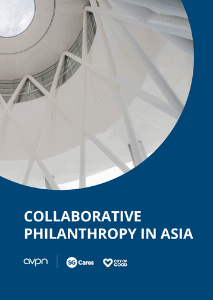The time is ripe for collaborative philanthropy in Asia. The amount of philanthropic capital is growing across the region, fuelling a diversifying and maturing philanthropic ecosystem that can function as the backbone for successful collaboration across issues, sectors and borders.
Against the backdrop of a rich history of community giving, innovative collaborative approaches are being driven by donors just as much as by grantees and communities. This multi-stakeholder engagement enables democratic solutions and supports effective systems change initiatives that focus on alleviating root causes of social problems, alongside funding remedial measures.
This white paper aims to unpack the concept of collaborative philanthropy and to serve as a resource for philanthropists and philanthropic organisations looking to partake in formalised collaborative efforts. It looks at the enabling environment in the region, describes different frameworks for collaboratives, and presents opportunities and challenges. It features case studies of philanthropic collaboratives both in the region and around the world
Some key insights that have emerged from the research include:
- The potential for collaborative philanthropy to facilitate integrated solutions for collective impact and systems change are immense. Philanthropic collaboratives are in a unique position to pool resources at scale, ensure credibility and visibility at a systems level and enable smooth multi-stakeholder collaboration.
- Defining a shared aim is key for the success of any philanthropic collaboration. Building trust takes time yet is essential to enable the alignment of values and empowered leadership. Clear and regular communication facilitates effective collaboration and ensures that the collaborative adapts to changes in the ecosystem and remains rooted in its local network.
- Technology is a key enabler in collaborative processes. The increasing private sector application and social sector adaptation of technology and data science can help to enable effective collaboration across sectors and stakeholders. Technology can enable and support collaborative operations, while data can drive collaborative strategy formation.


















